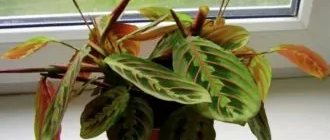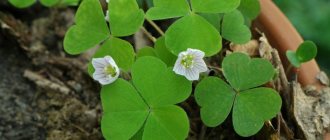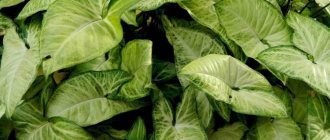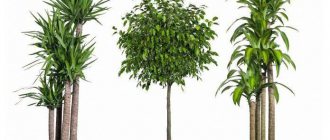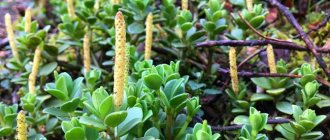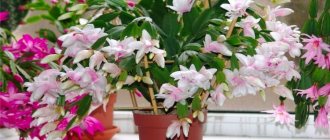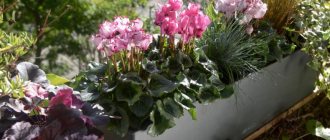Caring for tricolor arrowroot at home
Due to the difficulty of fulfilling all the requirements of arrowroot, flower growers consider this crop to be capricious.
But if you find an approach to the flower, it will respond with rapid growth, the constant appearance of new tricolor foliage and even flowering. Compared to the leaves of the tricolor arrowroot prayer plant, the photo of its flowers does not cause a storm of admiration. Some gardeners do not even suspect that their favorite forms spike-shaped sparse inflorescences with whitish or lilac small flowers rising above the rosette of leaves.
Caring for tricolor arrowroot at home must include:
- watering;
- feeding the plant in spring and summer;
- spring transplants carried out at two-year intervals;
- hygienic treatment of foliage from dust and removal of dead or damaged parts of the plant;
- maintaining air humidity.
Watering should be regular and abundant, and it is useful to use soft water at room temperature. The substrate should dry out a little between waterings. In summer and when heating is running in winter, the soil is moistened more often. If the room is cool, the watering schedule is adjusted.
Family Maranthaceae. Genus Calathea
Calatheas are plants with large leaves of original patterns and varied colors. Their pattern of stripes and spots can be of any shade - yellow or reddish-brown; solid green leaves are also possible. These are slimmer and taller plants. They are more impressive in appearance, but more difficult to cultivate. In skillful hands, they will grow simply in a pot, but they work much better in a terrarium or in a “bottle garden.” They are more sensitive to the slightest fluctuations in cold air (drafts), temperature and hardness of water when watering, as well as air humidity (required humidity is about 85-100 percent). In addition, many of the calathea cannot be subjected to a long procedure in the shower, and some do not tolerate spraying at all, for example Calathea Varshevich.
Calatheas are popular with gardeners for their beautiful patterned leaves. But there is Calathea with inconspicuous leaves, for example, Calathea crocata, but it is beautiful because it has orange-red flowers on straight graceful peduncles. Calathea makoyana, Calathea ornata, pinkish-colored Calathea roseopicta, painted Calathea picturata, Calathea veitchiana, Calathea Maui Queen, and Calathea Maui Queen look very effective medallion (Calathea medaillon), Calathea zebrina, Calathea bachemiana, Calathea lindeniana.
Features of care.
Features of the ctenant
All ctenants have the unique property of turning their leaves. We already know that arrowroots raise their leaves up at night, as in prayer, and straighten them in the morning - this is how they orient themselves in space relative to the light, for this in their homeland - in the countries of Latin America, all arrowroots are called praying plants.
Moreover, what’s interesting is that the plant chooses what is most convenient for it - it can raise the leaves up or down, almost perpendicular to the floor
Please note that if your plant suddenly presses its leaves to its petioles on a spring or summer day, it may be hot or dry! The sun may no longer shine through the window, but the leaves are still pressed against the petioles
By the way, all other arrowroots can behave in exactly the same way, but only in ctenanthas, stromanthus and some calathas (large long-petiolates), this process is more pronounced. In arrowroot, the growth of the stem is different - semi-creeping, forming many nodes, and the bush is compact, so the arrowroots also shrink from the heat, like bristling hedgehogs, or the leaves are pulled closer to the walls of the pot.
Thus, by observing your ctenanta (or other arrowroots), you can understand whether it is too hot, the sun is too intense, or both. To avoid burns and not overheat, the leaves will face the light. But if there is no sun, look at the thermometer - perhaps it is too stuffy, hot, remember how long ago you watered it.
In some cases, the leaves on one side of the plant are lowered and raised on the other, so you can observe the reaction to the flow of warm air from the battery and the orientation of the plant towards the light source.
Types of arrowroot: from exotic to home flower
Arrowroot species white-veined
This variety is distinguished by tuberous roots, and it grows up to 25–30 cm, the leaves are 15 cm round and reach 9 cm in width. Arrowroot is the most popular variety for planting at home.
Its leaves are dark green on top with silver veins, hence the name white vein, and may also have a light green pattern. The underside of the leaves is green-red, and the cuttings are very short, 2–3 cm.
In the home environment, this purebred variety is rarely found; its varieties are most often grown:
- Kerkhoven, which reaches only 15–20 cm in height. The size of the leaves of Kerkhoven's arrowroot is 15 cm, and the petioles are very short; flowering occurs with small white flowers. The color of the upper part of the leaves is dark green, distinguished by a longitudinal silver stripe and ocular black spots located on the sides of the central stripe.
- Massanja black. The variety is very similar to the previous species, but its color is dark green closer to black, and the spots are olive-colored.
- Tricolor (red-veined, the third name is fascinator) is surrounded by a halo of velvety leaves of a dark or light green shade, the shade becomes lighter towards the periphery. The lower part of the 10-centimeter leaf is crimson with pink veins, and the upper side is also veined, but red. Along the central vein there are spots that have a greenish-yellow color.
The last species is the most capricious white-veined arrowroot, and caring for it is fraught with difficulties.
Two-color arrowroot
This is a rare variety; the root system of the plant does not form tubers. The bicolor variety is distinguished by oval leaves with a longitudinal light vein, around which there are brown spots. The upper edge of the leaf is below, and closer to the cutting it becomes red.
Reed arrowroot
This variety grows up to 1 m in height and is a shrub. It has thick roots, more like tubers. Reed arrowroot is surrounded by long, 25 cm, leaves, they are pubescent at the bottom and have a green-gray color. The plant blooms with white small flowers.
If you like absolutely all types, then you can purchase a mix of different cuttings or separated bushes and germinate them. The flower is small, useful and will highlight the beauty of your apartment.
Types of arrowroot
Various types of arrowroot differ in the shape and color of the leaves. We have collected some of the most interesting varieties for home growing!
White veined arrowroot
Everything is clear here - white veins clearly appear across the entire surface of the leaves. Moreover, the plates themselves are also not monochromatic, but in all shades of green and with a red reverse.
Photo: flowersadvice.ru
Reed arrowroot
It got its name from the characteristic shape of its shoots. In addition, this is a very large species, which in favorable conditions easily grows above 1 m. The ovate leaves are pointed towards the end.
Photo: botanichka.ru
Maranta Maricella
Its rich green hue immediately attracts attention. But the veins and central line are lighter, light green or even whitish.
Photo: friendly-life.ru
Black arrowroot
Its second name is massage. This is a very capricious, but very decorative dwarf species up to 15 cm high. The leaves along the edge are so dark that they seem really black. But there is a white stripe down the middle.
Photo: flowers.ru
Maranta Kerkhoven
It has large leaves of an unusual round shape, most often slightly wavy. On a light background, dark brown spots are scattered, which diverge from the central vein.
Photo: fastbox.su
Arrowroot bicolor
Or just two-color. It is distinguished by striped colors of light and dark shades of green. And also - the structure of the root system, in which tubers do not form.
Photo: dom-florista.ru
Maranta tricolor
One of the most popular varieties for home growing. This arrowroot has bicolor leaves in varying shades of green and vibrant red veins.
Photo: domashniecvety.ru
Hamedorea (50 photos): types, cultivation and care at home
Features of growing arrowroot
Arrowroots are fairly shade-tolerant plants and develop well in diffused light. In winter, plants also need bright, diffused light. They do not tolerate direct sunlight during the spring and summer months. The size and color of the leaves depend on whether the plant is well protected from the sun. If the light is very bright, the leaves lose their color and the leaf blade decreases. Arrowroots grow very well under artificial lighting with fluorescent lamps for 16 hours a day.
White-veined arrowroot, variety Massangeana (Maranta leuconeura var. massangeana)
Arrowroots are quite thermophilic. In summer, the optimal temperature is +22…+24°C; overheating is also dangerous for plants. Monitor the soil temperature - it should not fall below +18°C. From October to February, during the dormant period, the optimal temperature for keeping arrowroot is +18...+20°C; In no case should the temperature drop below +10°C. The plant is very sensitive to temperature changes and drafts - they must be avoided.
Watering for arrowroot requires abundant, warm, soft water. The soil should be kept moist and not allowed to dry out between waterings during the growing period. In autumn and winter, watering is slightly reduced, and in cool conditions it is necessary to allow the surface of the substrate to dry out
It is important to ensure that the soil does not become waterlogged and that the root system is not allowed to cool.
Maranta prefers high humidity. It requires regular spraying throughout the year. Spray with well-settled or filtered water. For arrowroot, you need to choose a place with maximum air humidity.
When indoor air is dry, spraying is necessary at least once, and ideally twice a day. To increase humidity, the plant can be placed on a tray with damp moss, expanded clay or pebbles. In this case, the bottom of the pot should not touch the water.
From time to time, arrowroot can be washed in the shower. This procedure removes dust and moisturizes the leaves of the plant; during washing, you should cover the pot with a bag so that water does not get into the substrate.
Variegated reed arrowroot, variegata (Maranta arundinacea 'Variegata'). Mokkie
Often, despite measures to increase air humidity, the tips of the leaves of the plant dry out in room conditions. Arrowroots grow well, as already noted, in mini-greenhouses, florariums, and terrariums.
The plant needs fertilizing with both organic and mineral fertilizers. In spring and summer, arrowroot is fed once every 2 weeks with a highly diluted solution of mineral fertilizers, as well as with a highly diluted organic fertilizer.
Arrowroots are replanted, on average, after two years, in the spring, and the pot is taken a little larger than the previous one, preferably plastic (it holds moisture better). Dried and wilted leaves of the plant are cut off so that young shoots grow better.
For planting arrowroot, shallow pots are used (the root system of the plants is shallow); they must have good drainage, consisting of shards, expanded clay or coarse sand.
The plant prefers slightly acidic soil (pH about 6); it can be composed of leaf, humus, peat soil (1:1:1) or garden soil, peat and sand (3:1.5:1). It is useful to add dry mullein, crushed charcoal and a little pine soil to this mixture.
White-veined arrowroot, Kerchovea variety (Maranta leuconeura var. kerchoveana). Maja Dumat
When grown in a hydroponic culture or on an ion-exchange substrate, arrowroot forms powerful large-leaved low plants, without requiring replanting, transshipment and fertilizing for 2-3 years.
Calathea - a delicate beauty in a pot
Detailed description, misconceptions and care tips
Calathea is hard not to notice; it immediately attracts the eye and delights with the beauty of its leaves. Its oval leaf blade is covered with spots, varying degrees of pigmentation of which form an amazing pattern. The central vein is often highlighted in tone, the edge of the leaf is also emphasized in color, and the spotted pattern of the middle part, like the creation of an exquisite artist, lies with surprisingly regular strokes on the soft velvet or paper-glossy surface of the leaf. Calathea leaves sit on long petioles and point slightly upward, which allows you to see the beautiful shade of their reverse side, which is painted pink-lilac or purple-lilac.
Calathea or arrowroot?
Calatheas are often confused with their relatives, arrowroots, and, undoubtedly, they are very similar to each other, however, it is worth immediately distinguishing between these two genera of plants. They are connected by belonging to the same family - arrowroot, where Calathea occupies a leading place in terms of the size of the genus, and arrowroot, as a genus of plant, simply received its name from the name of the entire family. Despite the fact that calathea and arrowroot are fellow countrymen - their homeland is tropical forests in Central and South America - and they are also very similar in appearance, calling calathea an arrowroot is as wrong as saying that dracaena is a lily of the valley, because these two plants are also belong to the same family - Ruscus.
The main differences between calathea and arrowroot
An experienced eye will always find differences between them. Calathea is slimmer and taller due to its long petioles. It can grow up to 60 cm in indoor conditions, and up to 1 meter in height in conditions close to natural, while arrowroot is more squat and its maximum height is only 20-25 cm.
Calathea has oval or elongated leaves, in some species reaching 30 cm in length. The leaf plate is thin, delicate, the rosettes have only one fully developed leaf. The leaves of arrowroot are more round, ovoid, about 10 cm in length, and the main difference between arrowroot is that on its petioles the leaves are arranged in two rows, and on them you can count from 4 to 6 fully formed leaves.
Arrowroot inflorescences are always small and inconspicuous, while some species of Calathea are grown as decorative flowering plants. These are Calathea Saffron, with showy orange flowers, and Calathea Warshevich, which blooms with beautiful white or pink flowers - these types of calathea have less variegated leaves. They are also more whimsical, and it is very difficult to grow an adult flowering plant from them at home.
Features of care
Calathea is not for beginners in floriculture. This is a rather whimsical culture that requires increased attention. In nature, Calatheas densely populate swampy and flooded areas of the tropics, settle on the banks of rivers and lakes, often forming impenetrable thickets, so this type of plant loves high humidity and abundant watering.
However, there are also pitfalls here. If you choose the wrong soil and ignore good drainage, then, seemingly with the best intentions, the frequently watered calathea begins to die - violation of the maintenance conditions (inappropriate soil, low air temperature) and frequent watering lead to rotting of the roots. To reduce the risk of rotting, you need to add crushed charcoal to the ground, which has high sorption activity and is an antitoxin.
The spraying procedure, which must be carried out regularly when caring for calathea, also has its own specifics. Direct contact of large drops on the leaves can lead to the formation of dark spots, so you need to spray the plant from a distance, moistening more of the nearby area, and only allow small splashes to get on the plant itself. At the same time, the water temperature should not be cold, but not hot either, ideally 25-28 degrees.
But even constantly spraying calathea, it is difficult to create ideal conditions for it, close to the warm and humid natural climate. Here, the best solution would be to place the flower pot in a container filled with sphagnum - this is a special moss that can hold an amount of liquid 20 times its own weight. The sphagnum moss in the container is regularly saturated with water, which provides the plant with the necessary level of humidity, but you need to make sure that the water does not cover the bottom of the pot. Expanded clay is suitable for the same purpose. They fill the container with it, place a flowerpot inside it, and fill the bottom of the container with water to the level of the pot. Thus, a pot standing on expanded clay stones does not come into direct contact with water, while the flower is in conditions of high humidity.
The temperature in the room where the calathea is located should not be less than 18 degrees throughout the year. Calathea also reacts poorly to temperature changes and does not tolerate drafts. It is best to grow it in greenhouses. When caring for it at home, place the flower away from direct sunlight, otherwise burns may occur. At the same time, calathea loves good light, so it is ideal if taller flowers or trees live next to it, shielding it from the sun. Ficus, philodendron, and palm trees are well suited for this purpose, but you need to monitor the soil moisture of these plants.
Optimal conditions of detention
Temperature:
The thermal regime most suitable for calathea is from 22 to 25 degrees.
Lighting:
Calathea grows well in partial shade, but prefers a well-lit room where there is no direct rays of the sun.
Watering:
The soil in the pot should always be moist, but it should not become waterlogged. Calathea should be watered abundantly throughout the year.
Air humidity:
as already mentioned, humidity should be maximum.
Feeding:
Feeding should be done throughout the year, approximately once every 20 days.
Problems
Leaves are limp and wrinkled:
The reason for this is dry indoor air. Increase the number of sprays on the plant.
The leaves are drooping, the petioles are rotting:
this is a sign that the plant is suffering from low temperature in the room, temperature changes or drafts.
Leaves darken at the ends:
This is how the lack of air humidity affects the condition of the calathea.
Leaf spots:
light yellow - this is a burn - a sign of exposure to sunlight. Dark spots indicate over-spraying and droplets hitting the leaf.
The petioles are stretched and broken:
lack of light - place the flowerpot in a brighter place, and tie the plant or make a support for long petioles.
12/04/2011, Yulia Ermosh
Plectranthus - warnings
If your indoor mint has not taken root, then there can be no talk of any positive meaning. Fading plecanthus foretells the appearance on the horizon of serious financial problems and bad luck in this area of life. In addition, if a given indoor plant does not take root, it means that you are trying to achieve wealth in the wrong way. Perhaps you should change tactics, place of work or even field of activity.
Indoor mint fades with enviable regularity even among those who are destined to gain a lot of cones and gain valuable life experience before getting rich. Try to listen to your intuition better and take proper care of the plant, it just might work. But, as a rule, dying plants are not kept in the house, since they are considered a magnet for negative energy.
Plectranthus brings good luck and financial well-being, but only to brave, determined and strong-willed people.
This home plant also encourages a tendency to take calculated risks and healthy adventurism. If you notice a characteristic in yourself such as a tendency to give up when serious problems arise and a reluctance to solve them, indoor mint will not help you.
At the same time, people for whom plectranthus is ideally suited note a rapid improvement in their financial situation, a desire to work for their own benefit, and sometimes a desire to change jobs to something better. Lucky owners of this indoor plant are lucky in business, study and other matters.
Overall, plectranthus is ideal for anyone who wants wealth and well-being, but should never be neglected.
Reproduction
There are two simplest methods for propagating arrowroot.
Dividing the bush
The root system of the bush is carefully divided so that each resulting part has its own growth point. If there are damages, they are sprinkled with crushed activated carbon to avoid infection.
After this, each bush is planted in a separate container with a substrate, the foliage is trimmed and covered with film. You can tell that a plant has taken root by the appearance of new leaves and shoots.
Cuttings
A cutting with a pair of buds is cut from the plant. Its length should be at least 8 cm. It can be rooted in settled water or moistened soil. You will have to wait about a month for the roots to appear, sometimes longer. In this case, the cuttings should be placed in a dark place. When the roots appear, the arrowroot is planted in a pot with light soil and covered with film, providing greenhouse conditions. You can remove the shelter when new shoots appear.
Transfer
An adult arrowroot is replanted once every 2–3 years in the spring; young plants (up to 3–4 years old) can undergo this procedure annually.
After purchasing, the arrowroot should be replanted immediately. Typically, plants are sold in soil that allows them to be transported, but this soil is not suitable for proper development of arrowroot.
Since the root system of the plant is small, you will need a small pot (its diameter is 2–3 cm larger than the previous one). It is better to opt for plastic or glazed clay. Drainage is required at the bottom of the pot - pebbles or expanded clay.
A drainage layer of approximately 1/3 of the pot is required.
You can compose the soil yourself or purchase ready-made soil for arrowroot. The soil should allow air and water to pass through well, be loose and light. For the mixture you will need:
- leaf soil - 3 parts;
- peat - 1.5 parts;
- coniferous soil - 1 part;
- dry mullein - 1 part;
- sand - 1 part;
- ash - 0.3 parts.
If it is not planned to propagate arrowroot by dividing the bush, then it is replanted by rolling over an earthen ball with roots. Before planting a flower in a new container, you need to cut off the shoots, leaving only 1 internode on them. As a result, the new plant will have numerous shoots, forming a dense, beautiful bush. In the first month after planting, the plant does not need to be fertilized. You can cover the pot with a bag to retain moisture and quickly root.
Ktenanta is also popular among flower growers. You can learn how to care for this plant from the material:
Arrowroot is transplanted using the method of transferring an earthen clod
Video: Feng Shui talismans and their renewal. What to do with old talismans and Feng Shui symbols
Sep22 The teaching of feng shui (feng shui, feng shui, feng shui) arose in ancient China, but the truths of ancient Chinese philosophy about the internal and external harmony of human existence are still alive. Translated from Chinese, “Feng Shui” means “wind and water.” “Feng” is an energy stream that sweeps like the wind, “Shui” is streams of water that live in the depths of the earth and nourish it. The meaning of the philosophy of Feng Shui is to enhance the positive energy of a room, with the help of which a person could become happy, healthy and successful, and his life – harmonious and prosperous. The functions of home flowers are not just to decorate the interior. According to Feng Shui, indoor plants activate the positive energy of the premises, with the help of which they bring all aspects of our lives into a harmonious state. Harmony of masculine and feminine principles When starting to landscape an apartment according to Feng Shui, you should take into account the size, shape of plants, the color of their flowers - the degree to which they express the masculine (Yang) or feminine (Yin) principles depends on this. The sharp shape of the leaves indicates the predominance of the masculine principle of Yang in them, accelerating the movement of Qi energy. Leaves of a round shape indicate the predominance of the feminine principle of Yin in the plant. The predominance of the masculine or feminine principles is also expressed in the way the flower grows and branches: the stems of plants with Yin spread or hang down, with Yang - directed upward. The list of indoor plants according to Feng Shui, which have powerful positive energy, is very extensive. Depending on their properties, house plants, arranged according to the Feng Shui principle, will help to form the desired qualities of character, achieve harmony in personal or business relationships, and even promote the flow of creative energy in creativity and business. Personality harmony
Description
Arrowroot is an ornamental herbaceous perennial from the Marantaceae family. It is named after the medieval physician and botanist Bartolomeo Maranta. Sizes and appearance vary greatly depending on the variety. At home you can rarely find arrowroot taller than 30 cm, however, in natural conditions the height of the bush can reach one and a half meters. The leaves are large, patterned, and oval in shape. A young specimen has erect stems, but with age they lean more and more toward the ground.
This is interesting! With the onset of darkness, arrowroot raises its leaves to the sky, exposing their back side. This is very reminiscent of a believer folding his hands in prayer. This is where the plant got its second name - “Prayer Plant”. Arrowroot also has a third name, and, oddly enough, it is also associated with religion. The shape of the leaves resembles the tablets of Moses, and each leaf has 10 spots, just like the number of commandments on the tablets. That’s why some people call arrowroot the “10 Commandments.”
The root system of arrowroot is represented by tubers. The tubers of some arrowroot species are edible and are cultivated in several countries. Starch is also extracted from them for use in medicine.
This may be interesting: Monstera - caring for a beauty with a scary name
Arrowroot blooms in summer. Rare inflorescences appear from the top of the plant. The petals come in white, yellow and pink colors. After pollination, small seed pods appear in place of the flowers. Small, inconspicuous arrowroot flowers cannot compete with the beautiful leaf pattern, so most often they are removed at the formation stage so that the plant does not waste extra energy on flowering.
Landing
If arrowroot is grown separately, then the pot for the perennial should be selected in a small size. Rooting with other tropical crops will require placing the plants in wide but shallow containers. A composition of several tropical bulbous crops should be rooted while maintaining the distance between them for the free development of the root system. The bulbs should not contact each other.
The roots of arrowroot do not grow deep into the soil, but require space for further development.
When planting in containers or pots, care should be taken to ensure there is drainage at the bottom. For these purposes, you can use small fraction pebbles, expanded clay or crushed stone. As for the composition of the soil, for tropical perennials it is recommended to use light soil with good aeration and weak acidity. The substrate can be purchased at the store; for tricolor arrowroot, universal soil is suitable. The gardener can also prepare it himself.
The soil mixture will consist of the following components:
- humus - 2 parts;
- torus – 1 part;
- coniferous bark - 1 part.
As a useful addition, you can also include moss or charcoal. The last component can be replaced with calcined river sand.
Formation
If a ctenant grows uncontrollably, over the years it may lose its decorative appearance. Weak growth is formed, leaves that do not have enough space become smaller and turn yellow. In particularly advanced cases, you can act radically. Prune the plant completely, place the pot in partial shade and water very sparingly. After some time, the roots will give new, healthy growth.
But it’s better not to take it to extremes, but to regularly devote time to formation. It is necessary to remove deformed, elongated shoots, and trim dried or limp foliage. New leaves quickly take the place of the cut ones.
When pruning the ctenant, try to cut off branches with jointed knots. Then they can be used for cuttings. New roots will grow from these thickenings.
Diseases
If the conditions for keeping an indoor flower are not observed, some undesirable consequences may occur. So, the tips of leaves that are yellow or brown indicate that there is not enough or, conversely, an excess of nutrients in the soil. Slow growth will indicate a lack of moisture. If the leaves begin to curl, then it is necessary to water the plant more often.
They will begin to change their color and fall off more often and ahead of time. To control pests, a weak soap solution is used and each arrowroot leaf is treated with it.
If this method does not bring the desired result, it is important to use special preparations for pest control and use them strictly in accordance with the instructions.
With proper and careful care, arrowroot will delight you throughout the year with its beautiful and unusual appearance.
Arrowroot - leaves with amazing colors
At the first stage - dividing the bush - in the spring during transplantation, the earthen lump around the rhizome should be divided into two or three plants so that each tuber has several good roots and leaves. Each “young” arrowroot should be planted in a small pot and covered with a plastic bag until the flowers take root completely. The described method is used most often because it is the most effective.
When cutting in summer, cuttings 8-10 cm long are cut from the apical shoots of arrowroot and placed in a container with water until roots appear. After this, the seedlings are transplanted into a pot with loose substrate.
Diseases and pests of tricolor arrowroot
The main pests of arrowroot include spider mites and thrips, which usually appear when indoor air is extremely dry. Insecticides and systematic spraying of the plant will help get rid of them. A lack of moisture is indicated by yellowing and falling leaves. With irregular watering of the soil, tricolor arrowroot foliage becomes covered with small spots and curls up. And if the ends of the leaves turn yellow, it is recommended to fertilize.
SUITABLE FOR THE SUCH PLANTS: Calathea, Ctenantha, Stromantha, Marantha
Photo gallery
People awarded the second plant because one of its varieties has ten white spots on the leaves. Belongs to the Marantov family.
Arrowroot is not poisonous; you can safely transplant a flower without gloves. The plant does not require special care. The main thing is to maintain the temperature regime, water it abundantly, cut off dry leaves and replant it 2 times a year, in the spring.
Select a medium-sized pot - arrowroot does not have a very large root system. It has a positive effect on people: it perfectly purifies the air and improves sleep.
If you want to buy a flower that is similar to arrowroot, then ctenantha or calathea are excellent choices. The greatest similarity with praying grass is observed in the popular variety of ctenanta - lubbers. There are slight differences in appearance and methods of propagation - arrowroot propagates by shoots, and calathea by dividing the bush.
Pest and disease control
Gray-brown fungal spots on the leaves are a symptom of anthracnose, which occurs due to excess moisture or acidity of the soil. Due to sooty fungus, the leaf blades become covered with a grayish coating. In both of these cases, cut out the damaged parts of the plant and treat with fungicides.
At low air temperatures, arrowroot is affected by black rot. Then it needs to be transplanted and treated with Bordeaux mixture. Everything is more complicated if root collar rot occurs. In the later stages, it is unlikely that such a plant will be saved.
A scale insect hides on the leaves and stems of arrowroot and sucks the juices out of the plant. Sometimes the spider mite envelops the flower in its web. First, rinse the arrowroot thoroughly with warm water, or better yet, with soapy water. And then treat with insecticides.
Photo: seven-flower.ru
Hatiora (50 photos): types, care and cultivation at home
Flower care in winter
In winter, the plant never ceases to delight the gardener with its beauty, but its growth still slows down, and some of the leaves may turn yellow. At this time, you should limit watering and feeding the plant. When a flower pot is on the windowsill, it is not recommended to open the window; the plant does not like drafts. The root system of the plant should also be warm.
If the flower is located in the back of the room, it needs additional lighting. This could be a fluorescent lamp or a fluorescent lamp, which will help him feel good in winter.
Names of species and varieties: ctenanta oppenheim, burle-marx, lubbers and others
The genus Ctenanta has approximately 15 species. Five of them, as well as varieties bred by breeders, have become widespread in indoor floriculture.
- Oppenheim's tenantha is the most popular and tallest (more than 1 meter) species. The finely fleecy and large (about 45 cm) leaves have the shape of an elongated oval with a sharp end. They are located on high petioles and decorated with light green, silver or cream stripes. The underside is purple colored.
- Tricolor is a form of Oppenheim's ctenant with even more variegated leaves. They combine different shades of white, pink, green.
- Ctenanta Lubbersa is a well-known species in home floriculture. The height of the bush can reach up to 80 cm, but there is also a low-growing form - about 30 cm. The leaves are painted on top with a yellow pattern on a green field. The reverse side is light green.
- The Lubbers variety Brazilian Snow is distinguished by leaves with cream stripes. They are very wide and can occupy up to half of the leaf plate.
- Ctenanta Burle-Marx is a compact species, no higher than 40 cm. The oval, non-pointed leaves are colored in different tones of green, from silver-greenish to dark marsh. The spots are not scattered randomly, but create an ornament. The reverse side of the leaf plate is wine-burgundy.
- The Burle-Marx variety Amagris is an even smaller bush, no more than 30 cm. The silver-green leaves are decorated with contrasting veins on top. The reverse side is light purple.
- The pubescent (or bristly) ctenanta is very similar to Oppenheim's ctenanta. But the height is slightly lower - about 80 cm. The leaves at the base are wider, and the decorating stripes on them are narrower than those of Oppenheim's ctenanta. But the main difference between the pubescent variety is that the petioles are covered with small fibers.
- Ctenanta pubescent variety Gray Star is distinguished by pointed leaves of a bluish tint, a dark green pattern is traced along the veins. The underside is wine purple.
- Compressed ctenanta is also a tall species, about 1 m. At the tops of the smooth shoots there are four leaves. They are shiny and not so variegated in color compared to other ctenants. The leaf plate is of different shades of green.
- Ctenanthe pilosa is a species formerly called Ctenanthe pilosa. It is distinguished by elongated oval leaves (about 20 cm long). The main color is dark green, the spots are yellowish-light green.
- Ctenanta pleasant (amabilis) prefers to develop wider rather than upward, like arrowroot. The leaves are oval-elongated and silvery-green in color. Flower growers note that this species prefers more abundant watering than others.
Maranthaceae: description and photo
All representatives of the arrowroot family require the same growing conditions, so I decided to talk about them in one article. If you love decorative foliage plants and are ready to tinker with these sissies, read on, I will tell you everything I know about this family.
Maranta
I’ll start my story with arrowroot, which got its name in honor of the physician Bartolomeo Maranta, who lived in the Middle Ages. Arrowroots are low plants, no more than 30 cm high. Their homeland is the humid tropics of Brazil, where they grow under the canopy of large trees. Arrowroot flowers are small and inconspicuous, but the leaves are velvety, painted, and are the main decoration.
With age, a small arrowroot bush grows in width and can be used as an hanging plant. Arrowroot (and other members of the family) has an interesting feature: in the evening it raises its leaves upward, which looks like the folded palms of a praying person, which is why it is also called a “prayer plant.”
This movement of the leaves occurs because there is a swelling on the petiole at the place of attachment of the leaf blade, the cells of which change volume, as a result of which the angle of inclination of the leaf changes depending on the lighting.
White-veined arrowroot (M. leuconeura f. kerchoveana) has ten dark brown spots along the midrib. The most commonly found varieties on sale are “Red Prayer”, “Black Prayer” and “Green Prayer”, which differ from each other in different shades of spots.
Calathea
Calathea is another representative of the arrowroot family, which boasts the most diverse species. Some of them have beautiful not only leaves, but also flowers.
Calathea, in comparison with arrowroot, is a fairly tall plant, reaching a height of 60-70 cm. Velvet k. Warshewiczi (K. warshewiczi) and striped calathea (k.zebrina) in good conditions grow up to 120 cm. Their leaves have a tiered arrangement .
Stromanta
Calathea and stromanthus are often not separated, as they are biologically very close. Blood red stromanta (S. sanguinea) grows over a meter in height. The varieties “Triostar” and “Stripestar” have a dark crimson underside and differ from each other by spots and stripes on the upper side of the leaf.
In the evening, when the leaves “prayerfully” rise up, the plant changes its appearance: the white-green bush becomes dark crimson.
Ktenanta
Ctenanta is often indistinguishable from calathea, and when sold they are sometimes confused. In the store you can find C. burle marxii and C. oppenheimiana, which have painted leaves.
Arrowroot diseases
If you see that the arrowroot leaves are turning yellow, their ends are brown and dry, and the plant’s growth is slow, then most likely your flower does not have enough moisture and the air around the plant is too dry. It is necessary to increase the air humidity, spray the arrowroot more often, place the pot in damp peat or on pebbles with water in the pan.
Too dry air can lead to arrowroot leaves curling and falling off, as well as spider mite damage to the plant. Spider mites are very small red spiders. Appears on the underside of leaves and envelops them in thin white cobwebs. It is destroyed by spraying and washing the leaves, especially on the underside, with water, weak tobacco infusion with soap, pollination (in the fresh air, outside rooms) with ground sulfur, or the plant is treated with ready-made systemic insecticides.
When treating arrowroot leaves with infusions, after 2-3 hours the leaves should be washed with cool water. Treatment of the plant will have to be repeated several times until the pests are completely destroyed. To avoid damage by spider mites, the plant must be kept clean, frequently sprayed, and kept away from central heating radiators.
If the plant is kept cold and watered too hard, then diseases are inevitable for arrowroot. In this case, the flower’s stems and leaves will wither and rot; if the conditions of maintenance are not changed, the arrowroot will die.
Maranta (Maranta subterranea). Alex Popovkin
Arrowroots are demanding in terms of light conditions. If the light is too bright, the leaves lose color. If direct sunlight hits the leaves, they may burn. Arrowroots need diffused light. The arrowroot flower must be shaded from direct sunlight.
Problems with leaves. Table
| Symptoms | Causes |
| The tips of the leaves dry out and wither | Insufficiently humid air in the room. |
| Yellow or brown, but do not dry out. | Excess fertilizing or cold air, draft. |
| Leaves fall. | •low air humidity; •excessive watering; •acid soil. |
| The leaves dry out and curl. | If this is accompanied by a slowdown in growth, it means that the calathea does not have enough moisture or fertilizing. |
| Light spots on the leaves. | Sunburn caused by direct sunlight. |
| The leaves become long, thin and light. | Calathea lacks light. |
Diseases
With proper home care, the flower is resistant to diseases, but excessive watering can lead to root rot. In this case, it is necessary to urgently replant the plant with a complete replacement of the soil and flowerpot, removing all damaged parts of the flower.
Errors when leaving
As a result of improper care, calathea loses its decorative appearance, it is affected by diseases and pests, and the plant dies. Thus, the wrong choice of soil and an inappropriate level of humidity in the room cause problems with the leaves of the flower, which lose their decorative effect, dry out and fall off, and excessive watering leads to rotting of the roots.

